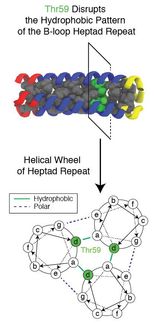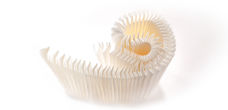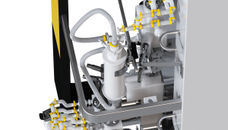Structural biology: Special delivery
Bulky globular proteins require specialized transport systems for insertion into membranes. Ludwig-Maximilians-Universitaet (LMU) in Munich researchers have determined the structure of such a system for the first time, and propose that it exploits the principle of the airlock.
Many proteins that are essential for cell viability must be transported across the membranes of intracellular organelles - such as mitochondria - in order to reach their sites of action. As a rule, transmembrane transport takes place before the newly synthesized protein has folded into its final functional shape, as the unfolded form can be extruded through a relatively narrow pore. The passage of folded proteins is a more difficult operation. They take up more space, so the pore must be correspondingly larger. Bacteria and chloroplasts utilize dedicated tunnels for this purpose. Although they are evolutionarily related to bacteria, mitochondria lack this type of aperture. Nevertheless, they manage to transfer one important protein in its folded state across their inner membrane. Now, researchers led by Professor Roland Beckmann at the LMU Gene Center have reported evidence which suggests that mitochondria accomplish this challenging feat by making use of the airlock principle. Beckmann and colleagues describe their findings in a paper that appears in the journal Nature Structural and Molecular Biology.
The Rieske protein (named Rip1 in baker's yeast) belongs to the 'iron-sulfur' class, and is a vital component of the process that enables mitochondria to generate ATP, which serves as the universal energy donor for biochemical reactions in cells. Rip1 is synthesized in a precursor form by cytoplasmic ribosomes, and transported in its unfolded state across the outer and inner membranes of the organelle into the compartment known as the matrix. Here, it is processed to yield the Rip1 protein. Incorporation of an 'iron-sulfur center' then allows it to adopt its functional conformation. Now, however, this globular protein must be inserted back into the inner membrane.
"Earlier work by our partners Walter Neupert and Nikola Wagener had shown that, in yeast, an enzyme called Bcs1 is involved in this final step," says Lukas Kater, lead author of the paper. "We have now determined the 3D structure of this enzyme with the aid of cryo-electron microscopy. - In fact, this is the first high-resolution structure of a eukaryotic translocator for folded proteins yet published." With a detailed map of the enzyme's configuration to hand, the team set out to decipher how Bcs1 manages to selectively mediate the passage of the folded form of Rip1 through the inner membrane without allowing other molecules or ions to slip through the pore.
Bcs1 belongs to a class of enzymes called AAA-ATPases. These typically consist of six identical subunits, which together form a ring-like pore. However, the structural data for Bcs1 revealed that it is comprised of seven subunits, and therefore forms a larger pore. But that's not all. - The pore is divided into two clearly defined chambers. One of these is directly accessible from the matrix of the mitochondrion, while the other is located within the inner membrane. Crucially, they are linked by a central domain which forms a seal between them - which can however be transiently opened, as the team went on to show.
"We therefore propose that transport through Bcs1 exploits the airlock principle," says Beckmann. The Rieske protein first passes through the large pore and into the matrix chamber. This induces a conformational change in Bcs1, which causes the seal between the two chambers to open, allowing Rip1 to enter the airlock, the chamber within the inner membrane. In the next step, the seal that separates the two chambers forms again. "We assume that the airlock then opens to provide access to an exit that allows the domain that contains the iron-sulfur center to emerge into the intermembrane space," Kater adds.
The results of the study not only provide insights into function and mode of action of Bcs1, it should also shed light on a number of mitochondrial diseases that have been linked to it, such as Gracile syndrome, which can lead to early postnatal death, and Björnstad syndrome which is associated with hearing loss. The availability of a high-resolution structure for the protein should make it possible to understand why the mutations associated with these diseases have such devastating consequences.
Original publication
Lukas Kater, Nikola Wagener, Otto Berninghausen, Thomas Becker, Walter Neupert, Roland Beckmann; "Structure of the Bcs1 AAA-ATPase suggests an airlock-like translocation 3 mechanism for folded proteins"; Nature Structural and Molecular Biology 2020





























































